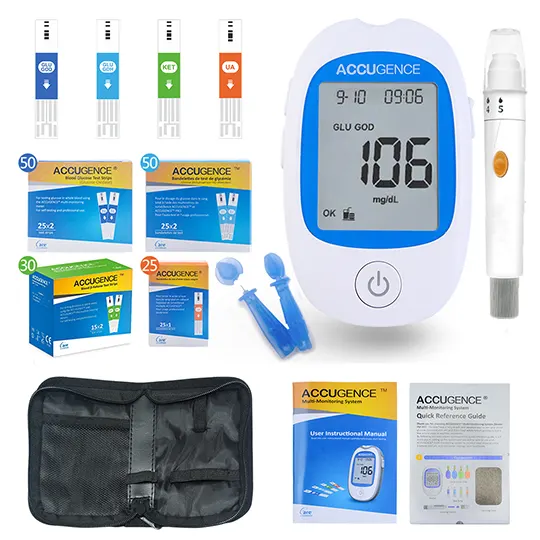Dosing and uses of Accuretic (quinapril/hydrochlorothiazide)
Adult dosage forms and strengths
quinapril/hydrochlorothiazide
tablet
- 10mg/12.5mg
- 20mg/12.5mg
- 20mg/25mg
Hypertension
Initial: 10 mg/12.5 mg or 20 mg/12.5 mg PO qDay
Increase either or both components based on clinical response
Do not increase hydrochlorothiazide component more often than q 2-3 weeks
To minimize dose-independent side effects, it is usually appropriate to initiate combination therapy only after inadequate response to quinapril monotherapy or significant potassium loss resulting from hydrochlorothiazide monotherapy
Renal Impairment
CrCl ≥30 mL/min: No dosage adjustment
CrCl <30 mL/min/1.73 m² or serum creatinine ≥3 mg/dL: Not recommended
Pediatric dosage forms and strengths
<18 years: Safety and efficacy not established
Accuretic (quinapril/hydrochlorothiazide) adverse (side) effects
No adverse effects specific to the combination have been observed; adverse effects limited to those previously reported with quinapril and hydrochlorothiazide
Quinapril
1-10%
- Dizziness (4-8%)
- Headache (2-6%)
- Cough (2-4%)
- Hyoptension (3%)
- Fatigue (3%)
- Hyperkalemia (2%)
- Chest pain (2%)
- Nausea/vomiting (1-2%)
- Rash (1%)
- Hyperkalemia (2%)
- Myalagia (2-5%)
- Back pain (1%)
Frequency not defined
- Angioedema
- Acute renal failure
- Alopecia
- Angina
- Pancreatitis
- Hyperkalemia
Hydrochlorothiazide
Frequency not defined
- Anorexia
- Epigastric distress
- Hypotension
- Orthostatic hypotension
- Photosensitivity
- Anaphylaxis
- Anemia
- Confusion
- Erythema multiforme
- Stevens-Johnson syndrome
- Exfoliative dermatitis including toxic epidermal necrolysis
- Hypomagnesemia
- Dizziness
- Headache
- Hyperuricemia
Warnings
Black box warnings
Quinapril: Discontinue as soon as possible when pregnancy is detected; affects renin-angiotensin system causing oligohydramnios, which may result in fetal injury and/or death
Contraindications
Hypersensitivity to either component or sulfonamides
History of hereditary or angioedema associated with previous ACE inhibitor treatment
Do not coadminister with aliskiren in patients with diabetes mellitus or with renal impairment (ie, GFR <60 mL/min/1.73 m²)
Pregnancy (2nd and 3rd trimesters): significant risk of fetal/neonatal morbidity and mortality
Cautions
Dual blockade of the renin angiotensin system with ARBs, ACE inhibitors, or aliskiren associated with increased risk for hypotension, hyperkalemia, and renal function changes (including acute renal failure) compared to monotherapy
May aggravate digitalis toxicity
Sensitivity reactions may occur with or without history of allergy or asthma
Risk of male sexual dysfunction
Renal impairment may occur
Acute transient myopia and acute angle-closure glaucoma has been reported, particularly with history of sulfonamide or penicillin allergy (hydrochlorothiazide is a sulfonamide)
Angioedema of the face, extremities, lips, tongue, glottis, and larynx has been reported in patients treated with angiotensin-converting enzyme inhibitors
If laryngeal stridor or angioedema of the face, tongue, or glottis occurs discontinue therapy and institute appropriate therapy immediately
Patients receiving coadministration of ACE inhibitor and mTOR (mammalian target of rapamycin) inhibitor (eg, temsirolimus, sirolimus, everolimus) therapy may be at increased risk for angioedema
Intestinal angioedema has been reported in patients treated with ACE inhibitors
Cholestatic jaundice may occur, which may progress to fulminant hepatic necrosis; discontinue
Dry hacking nonproductive cough may occur within few months of treatment; consider other causes of cough prior to discontinuation
Hyperkalemia may occur with ACE inhibitors; risk factors include renal dysfunction, diabetes mellitus, and concomitant use of potassium sparing diuretics and potassium supplements; use cautiously if at all with these agents
Thiazide diuretics may cause hypokalemia, hypochloremic alkalosis, hypomagnesemia, and hyponatremia
Hydrochlorothiazide may precipitate gout in patients with familial predisposition to gout or chronic renal failure
Symptomatic hypotension with or without syncope can occur with ACE inhibitors; mostly observed in volume depleted patients, correct volume depletion prior to initiation; monitor closely when initiating and increasing dosing
Agranulocytosis, neutropenia, or leukopenia with myeloid hypoplasia reported with other ACE inhibitor; patients with renal impairment are at high risk; monitor CBC with differential in these patients
Photosensitization may occur
Hydrochlorothiazide may cause acute transient myopia and acute angle-closure glaucoma that may occur within hours of initiating therapy; discontinue therapy immediately in patients with acute decreases in visual acuity or ocular pain; additional treatment may be needed if uncontrolled intraocular pressure persists
Use caution in patients with severe aortic stenosis; may reduce coronary perfusion resulting in ischemia
Use hydrochlorothiazide with caution in patients with diabetes or at risk of diabetes; may see increase in glucose
Use caution in patients collagen vascular disease, especially in patients with concomitant renal impairment
Thiazide diuretics may decrease renal calcium excretion; consider avoiding use in patients with hypercalcemia
Pregnancy and lactation
Pregnancy category: C (1st trimester); D (2nd & 3rd trimester)
Lactation: Excreted in breast milk, use caution
Pregnancy categories
A: Generally acceptable. Controlled studies in pregnant women show no evidence of fetal risk.
B: May be acceptable. Either animal studies show no risk but human studies not available or animal studies showed minor risks and human studies done and showed no risk.
C: Use with caution if benefits outweigh risks. Animal studies show risk and human studies not available or neither animal nor human studies done.
D: Use in LIFE-THREATENING emergencies when no safer drug available. Positive evidence of human fetal risk.
X: Do not use in pregnancy. Risks involved outweigh potential benefits. Safer alternatives exist.
NA: Information not available.
Pharmacology of Accuretic (quinapril/hydrochlorothiazide)
Mechanism of action
Accuretic is a fixed-combination tablet that combines an angiotensin-converting enzyme (ACE) inhibitor, quinapril hydrochloride, and a thiazide diuretic, hydrochlorothiazide
Quinapril competitively inhibits angiotensin-converting enzymes resulting in decreased plasma angiotensin II concentrations and consequently, blood pressure may be reduced in part through decreased vasoconstriction, increase renin activity, and decrease aldosterone secretion
Hydrochlorothiazide is a thiazide diuretic that inhibits Na reabsorption in distal renal tubules resulting in increased excretion of Na+ and water, also K+ and H+ ions
Pharmacokinetics
QuinapriL
- Half-Life: 0.8 hr (quinapril); 3 hr (quinaprilat)
- Onset: 1 hr
- Duration: 24 hr
- Peak Plasma Time: 1 hr (quinapril); 2 hr (quinaprilat)
- Bioavailability: ≥60%
- Protein Bound: 97%
- Metabolite: Quinaprilat (active)
- Metabolism: Liver
- Excretion: Urine (50-60% primarily as quinaprilat)
- Dialyzable: Minimally
Hydrochlorothiazide
- Half-Life: 6-15 hr
- Bioavailability: 70%
- Onset: 2 hr (diuresis); 4-6 hr (peak effect)
- Duration: 6-12 hr (diuresis); 1 wk (HTN)
- Vd: 3.6-7.8 L/kg
- Peak Plasma:1.5-2.5 hr
- Protein Bound: 68%
- Metabolism: Minimally metabolized
- Clearance: 335 mL/min
- Excretion: Urine 50-70%
- Dialyzable: No



